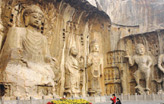Society
Long vigil over a dead reactor
Updated: 2011-03-27 07:28
(New York Times)
|
The abandoned Middle School No. 3 decays in Pripyat, Ukraine, in the contaminated area surrounding Chernobyl. Joseph Sywenkyj for The New York Times |
 |
Chernobyl, Ukraine
Twelve times a month - the maximum number of shifts the doctors will allow - Sergei A. Krasikov takes a train across the no man's land and reports for work here at a structure enclosing Reactor No. 4 known as "the sarcophagus."
Among his tasks is to pump out radioactive liquid that has collected inside the burned-out reactor. This happens whenever it rains. The sarcophagus was built 25 years ago in a panic, as radiation streamed into populated areas after an explosion at the reactor, and now it is riddled with cracks.
Water cannot be allowed to touch the thing that is deep inside the reactor: about 200 tons of melted nuclear fuel and debris, which burned through the floor and hardened. This mass remains so highly radioactive that scientists cannot approach it. But years ago, when they managed to place measurement instruments nearby, they got readings of 10,000 rem per hour, which is 2,000 times the yearly limit recommended for workers in the industry.
Mr. Krasikov has been overseeing this monster for eight years. He'll stay until he is pensioned off and then leave his job to another man, until he is pensioned off. Asked how long this will continue, Mr. Krasikov shrugged.
"A hundred years?" he ventured. "Maybe in that time they will invent something."
The death of a nuclear reactor has a beginning; the world is watching this unfold now on the coast of Japan. But it doesn't have an end.
While some radioactive elements in nuclear fuel decay quickly, others, like cesium and strontium, persist much longer. The contaminated area here - designated by Ukraine's Parliament as 39,000 square kilometers - will be affected for more than 300 years.
To visit Chernobyl today is to feel time passing.
In Pripyat, the plant workers' former community, where 50,000 people were given a few hours to evacuate, the wild world is gradually pressing its way in. Anton Yukhimenko, who leads tours of the dead zone, said that wild boars and foxes had begun to take shelter in the abandoned city.
The public is not allowed within 48 kilometers of Reactor No. 4, but a photographer and I made the journey this month with Chernobylinterinform, a division of Ukraine's Emergency Ministry. At the checkpoint leading to the exclusion zone, there is a small statue of the Virgin Mary and a placard listing the amounts of cesium and strontium found in mushrooms, fish and game.
At the 10-kilometer radius begins the zone of mandatory resettlement. A stand of scorched-looking trees marks the so-called Red Forest, after the color of dead pines that were bulldozed en masse and buried in trenches. As we approached the plant, the guides' radiation detector suddenly registered 1,500 microrem - 50 times normal, they said, perhaps because we had been caught by a gust of wind.
At the center of it all is the sarcophagus, its sides streaked with rust.
Since the early 1990s, Ukrainian officials have been working on a plan to replace it, launching a project called the New Safe Confinement, a 90-meter steel arch that will seal off the reactor for the next 100 years. Its cost is estimated at $1.4 billion, to be paid largely by donor nations. The project has been beset by delays and financing shortfalls.
In the meantime, the winter's snows are turning to rain, and rainwater leaking into the reactor could have unpredictable results, said Stephan G. Robinson, a nuclear physicist who works for Green Cross Switzerland, an environmental organization.
"In winter, it will freeze," said Dr. Robinson. "Water expands, and it breaks. Then maybe some of the inside collapses. A little cloud disappears through a crack. If there's rain, it means there is a way in. And if there is a way in, there is also a way out."
But even after the arch is built, Mr. Krasikov doubts that it will be possible to end the long vigil over Reactor No. 4.
"Nobody knows what to do with what is inside," he said. "There will be enough work for my children and my grandchildren."
By evening, on our way out of the site, light is tilting through the pine forests. Workers stream out through a wall of man-sized Geiger counters, making their way out of the exclusion zone and down the battered highway.
Tomorrow, they will come back to Chernobyl Atomic Energy Station for another day of work.
Specials

Tea-ing up
More turning to Chinese tea for investment opportunities like vintage wine

A cut above
The ancient city of Luoyang is home to a treasure trove of cultural wonders.

Rise and shine
The Chinese solar energy industry is heating up following recent setbacks in the nuclear sector
